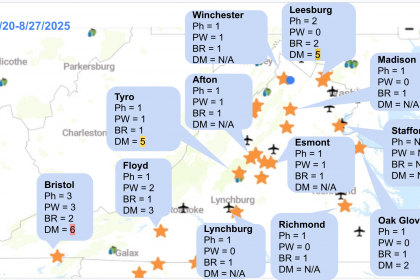Here’s a snapshot from the last week, showing the number of days with the risk of each disease: Ph = Phomopsis, PW = Powdery mildew, BR = Black rot, and DM = Downy mildew. This information was made available through Wine Board-funded the Sentinel Vineyard project.

The image above is just a summary of the past 7 days. Please visit https://newa.cornell.edu/ to obtain more detailed information. You can check daily weather data as well as disease and insect pest model results including forecasted risks. We paid the annual fee so that growers in Virginia can freely access NEWA.
The lack of risks of black rot and Phomopsis (NOTE: they are not critical diseases at this time of the season), but a high number of downy mildew risk days in many stations probably indicate the high risk of spore production due to high relative humidity at night. Sometimes heavy dew (= moisture running off from leaves) can be enough to spread the downy mildew pathogen.
At this point, many of us probably still have some cultivars to be harvested. Make sure to talk to your winemaker for fungicide selection. Our focus will be on downy mildew and late-season rots. You can find specific material information in this post (mid-season disease management), this post (VVA presentation), or a recent reminder.
The list of short PHI (< 7-day) materials is here (pdf format).
The risk information above is just output from the model, and the spray decision needs to be based not only on the weather condition but on the cultivar and history of the disease(s) in your vineyard.
If you are in an unfortunate situation where downy mildew was well established (i.e., you can see it everywhere), please use captan or copper to keep your healthy leaves protected. Clusters are resistant to new infection at this point, but if you do not protect leaves, downy mildew can defoliate leaves. Please do not use Revus, Ranman, or Ridomil which are prone to develop fungicide resistance.





